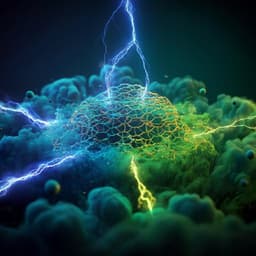
Chemistry
Regulation of functional groups on graphene quantum dots directs selective CO2 to CH4 conversion
T. Zhang, W. Li, et al.
This groundbreaking research, conducted by Tianyu Zhang and colleagues, reveals how functionalized graphene quantum dots can efficiently steer CO2 electroreduction towards high selectivity for CH4 production. Their innovative approach enhances methane yield significantly, promising to reshape catalyst design for sustainable chemical synthesis.
~3 min • Beginner • English
Introduction
Electrochemical reduction of CO2 (CO2RR) offers a pathway to close the carbon cycle and store renewable energy, but practical deployment is limited by catalysts that selectively produce a single high-order hydrocarbon at high rates. Most transition metals favor the competing hydrogen evolution reaction; Au, Ag, Sn, and Bi mainly yield CO or formate via 2e− pathways. Cu uniquely produces C1–C2 hydrocarbons and C2+ oxygenates but with broad product distributions. Carbon-based, metal-free catalysts are attractive due to cost and tunable electronic structures, yet typically favor 2e− products (CO, HCOO−). Graphene quantum dots (GQDs), with abundant edge sites amenable to doping/functionalization, have shown Cu-analogous multi-carbon activity when N-doped but still require improved selectivity and productivity toward one product. This study tests the hypothesis that tuning GQD surface functionality, specifically installing electron-donating versus electron-withdrawing groups, can regulate local electronic structure to direct CO2RR selectively toward CH4 with high efficiency and rate.
Literature Review
Heteroatom-doped carbons (N, B, S, P) can create active sites by modulating local charge density and have achieved competitive activity for CO or formate, rivaling Ag/Au/Bi/Sn, but typically do not yield high-order products. Prior advances include N-doped diamond (acetate selectivity), N/B co-doped diamond (ethanol), and N-doped mesoporous carbons (ethanol), where sp3 carbon or ordered mesopores stabilize key intermediates. N-doped GQDs reached 57% FE for multi-carbon and 15% for CH4 at −200 mA cm−2, attributed to enriched edge sites and pyridinic-N. Surface functionalization is a complementary strategy to doping, capable of altering catalyst electronic structure and adsorbate binding; prior studies on functionalized carbons and molecularly engineered catalysts indicate that pendant groups can influence CO2RR pathways and selectivities.
Methodology
- Catalyst synthesis: Pristine GQDs (p-GQDs) synthesized via alkali-mediated hydrothermal molecular fusion of nitrated pyrene. Post-treatments: oxidation in dilute air (o-GQDs) and hydrothermal reduction (r-GQDs). Additional reduced-from-oxidized sample (ro-GQDs). EDG functionalization with amine via precursor substitution during p-GQD synthesis: NH3·H2O (GQD-NH2-L) and N2H4 (GQD-NH2-H). EWG functionalization via Na2SO3 (GQD-SO3). Detailed temperatures, durations, and solvent compositions provided; dialysis and filtration used to purify dispersions.
- Characterization: TEM/HRTEM for morphology (lateral size 1–4 nm range), Raman (ID/IG ~1), XPS (C 1s, O 1s, N 1s) to quantify functional groups and nitrogen configurations, FTIR to identify –OH, –C=O, –COOH, –NH2, –SO3 groups. ICP-MS quantified trace metals (Cu and others) in GQDs and GDEs; acid digestion protocols specified.
- Electrochemical testing: Customized flow cell with gas diffusion electrode (GDE) made by spray-coating GQDs ink (2 mg GQDs, Nafion binder in IPA/H2O) onto Sigracet 34BC/39BB (active area 1 cm2). Electrolyte: 1 M KOH circulating on both cathode/anode sides at 0.5 mL min−1. CO2 feed 15 sccm; outlet mixed with 10 sccm Ar for flow calibration. Potentiostatic control; potentials vs RHE monitored. Gas products quantified by GC; liquid products by 1H NMR. Alternating CO2/Ar control runs, and 13CO2 isotopic labeling performed. CO reduction reaction (CORR) tests conducted for mechanistic insight.
- Data analysis: Faradaic efficiencies and partial current densities computed using calibrated outlet flows. Correlated FE(CH4) and jCH4 with atomic contents of –OH, –NH2, –COOH, –C=O from XPS/FTIR.
- Computation (DFT): VASP with PBE, 400 eV cutoff, Gaussian smearing (σ=0.05 eV), converged to <0.01 eV/Å and 1e−5 eV/atom. Periodic models of blank and functionalized GQDs. Charge density difference and Hirshfeld charge analyses linked functionalization to local charge on putative active sites (neighboring C/N at positions 1–5). Free energy diagrams for CO2-to-CH4 on C and N sites at different positions; evaluated RDS barriers and adsorption of key intermediates (*COOH, *CH2O, *CO). Explored configurations varying functional group type, density, position, defects, and N-dopant arrangements. Modeled effect of applied negative charge (electron injection) on adsorption energetics.
Key Findings
- EDGs promote CO2-to-CH4; EWGs suppress CO2RR and favor HER.
- r-GQDs (–OH-rich: C–O 84.5%, 30.8 at.% O content) deliver CO2RR FE up to 79.5% at −0.84 V; FE(CH4)=64.5% at −0.84 V with jCH4=−140.9 mA cm−2; at −0.92 V, jCH4=−179.6 mA cm−2. Pristine p-GQDs: FE(CH4)=28.1% at −0.97 V (jCH4=−42.0 mA cm−2). Oxidized o-GQDs (–C=O/–COOH-rich) show low CO2RR: total FE 11.1% at −0.95 V; max FE(CH4)=7.9%, jCH4=−9.2 mA cm−2.
- ro-GQDs (converted –COOH/–C=O to –OH; C–O 72.0%, –OH 25.6 at.%) achieve FE(CH4)=70.0% at −0.90 V with jCH4=−200 mA cm−2. Positive correlation between –OH atomic content and both FE(CH4) and jCH4 across p-, o-, r-, and ro-GQDs.
- NH2-functionalized GQDs: GQD-NH2-H (amine N 8.0 at.%, total N 28.5 at.%) attains FE(CH4)=70.0% at −0.95 V and jCH4=−201 mA cm−2; GQD-NH2-L (amine N 3.9 at.%, total N 18.6 at.%) max FE(CH4)=48.0% and jCH4=−132 mA cm−2 at −0.95 V. Stronger electron donation yields higher CH4 productivity. Stable over 10 h at −0.95 V without degradation.
- EWG-functionalized GQDs (e.g., GQD-SO3, S 10.9 at.%) show low CO2RR selectivity (total FE 15.9% at −0.86 V), similar to o-GQDs.
- Isotopic labeling with 13CO2 confirms carbon source: strong m/z signals for 13CH4 (m/z 17) and 13C2H4 (m/z 30). Alternating CO2/Ar feeds show CH4 only during CO2 supply.
- Metal impurity controls: r-GQDs contain <0.5 µg g−1 Cu; clean-r-GQDs (after acid wash/dialysis; high-purity KOH) still deliver FE(CH4)=65% at −0.98 V, jCH4=153 mA cm−2. GDL contains ~1.9 µg g−1 Cu but is inert to CO2RR. Estimated Cu loading on GDE (~47.3 ng cm−2) is too low to account for observed activity.
- C2 products: EDGs (–OH, –NH2) yield up to 12% FE for C2 products, versus ~3% for –COOH-rich samples; C2 partial currents increase with EDG content.
- Structure–function: XPS/FTIR show p-GQDs enriched in –C=O (73.4% of O species), o-GQDs in –C=O/–COOH (87.6%), r-/ro-GQDs in –OH. Raman/TEM show similar graphitization and sizes; performance changes attributed to functional groups, not defect density.
- DFT: At position-3 sites, predicted activity trend blank < –COOH < –OH < –NH2; N sites thermodynamically more favorable than C for CH4 pathway. EDGs increase local charge density (conjugation effect dominates) and can orient/stabilize intermediates (*CH2O) via interactions; applying negative charge converts physisorbed *CO and *CH2O to chemisorbed with strong adsorption energies (−0.98 and −1.55 eV).
Discussion
Functional group electronics govern CO2RR on GQDs. Electron-donating substituents (–OH, –NH2) increase electron density at adjacent pyridinic N and edge C, strengthening adsorption and facilitating hydrogenation of key intermediates beyond CO, thereby steering selectivity to CH4 at high current densities. Electron-withdrawing groups (–COOH, –SO3) reduce local electron density, weakening binding of intermediates and favoring HER, leading to low CO2RR selectivity. The clear positive correlation between EDG content and CH4 FE/jCH4 across multiple GQD series supports a generalizable design rule linking electron-donation strength and density to CH4 productivity. DFT analyses rationalize the experimental trends: EDGs elevate charge at nearby sites (particularly position-3 relative to the functional group), lower the rate-determining barrier for CO2-to-CH4 on N sites, and can stabilize *COOH and especially *CH2O via electronic interaction and orientation effects. Simulations also suggest potential-dependent adsorption strengthens *CO and *CH2O binding under cathodic bias. CORR tests indicate similar overpotentials to CO2RR for CH4 formation, implying CO formation is not rate-limiting and that *CO is a key intermediate on EDG-functionalized GQDs. While trace metals were carefully quantified and controls indicate negligible contribution, the authors note that a synergistic effect between trace Cu and GQDs cannot be fully excluded with current data. Overall, tailoring surface functionality on GQDs enables metal-free catalysts with Cu-like CH4 selectivity but at lower overpotentials, advancing understanding of molecular-level design principles for carbon catalysts.
Conclusion
This work demonstrates that surface functionalization of graphene quantum dots with electron-donating groups directs highly selective and active CO2-to-CH4 conversion, achieving up to 70% FE at −200 mA cm−2 jCH4 and industrially relevant current densities. Electron-withdrawing groups suppress CO2RR and favor HER. The activity scales with both the strength and content of EDGs (–NH2 > –OH), and EDGs also enhance formation of C2 products. Mechanistically, EDGs elevate local charge density at neighboring N/C sites and stabilize key intermediates, consistent with DFT predictions that identify pyridinic N at position-3 as especially favorable. These insights provide a molecular-level strategy to design metal-free carbon catalysts for targeted CO2RR products. Future work should pinpoint the exact active site structures under operating potential, quantify the role of electric fields and solvation on adsorption energetics, and rigorously assess any potential synergy with trace metals to fully exclude their contribution. Extending functional group chemistry and tandem designs may further improve selectivity and productivity toward specific hydrocarbons and oxygenates.
Limitations
- Active site identification remains indirect; spectroscopic and computational evidence suggest neighboring pyridinic N/C sites near EDGs, but definitive operando characterization is lacking.
- DFT models required charge injection to achieve chemisorption of *CO and *CH2O; neutral models did not bind these intermediates, indicating sensitivity to model assumptions about potential/charging and possible discrepancies from true catalytic sites.
- Trace metal impurities (e.g., Cu at ng–µg g−1 levels) were minimized and controls suggest negligible activity, yet complete exclusion of synergistic effects between trace metals and GQDs is not possible with current data.
- Gas diffusion substrates contain trace Cu; although tested inert, residual contributions under different conditions cannot be categorically ruled out.
- Correlations between EDG content and activity are strong but may conflate effects of group density, positioning, and local microenvironment; systematic control of spatial arrangement remains challenging.
Related Publications
Explore these studies to deepen your understanding of the subject.







